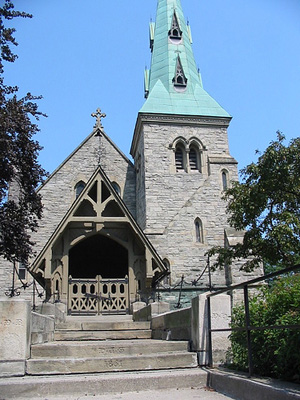Chapel of St. James-the-Less National Historic Site of Canada
Toronto, Ontario

General view
© Chapel of St. James-the-Less, Alan Brown, July 2006.
Address :
635 Parliament Street, Toronto, Ontario
Recognition Statute:
Historic Sites and Monuments Act (R.S.C., 1985, c. H-4)
Designation Date:
1990-02-23
Dates:
-
1857 to 1861
(Construction)
Event, Person, Organization:
-
Fred Cumberland, Cumberland and Storm
(Architect)
Other Name(s):
-
Chapel of St. James-the-Less
(Designation Name)
Plaque(s)
Existing plaque: St. James Cemetery, beside church 635 Parliament Street, Toronto, Ontario
In its vigorous, harmonious composition, this small funeral chapel is a splendid example of High Victorian Gothic design. Its sense of strength and spirituality is derived from the subtle contrast of its stone walls, enveloping roofs, and soaring spire. The chapel was erected in 1860 to plans by Cumberland and Storm, one of Toronto's leading 19th-century architectural firms. Situated on a slight rise, St. James is enhanced by the picturesque setting of its cemetery, which was opened in 1844 and is the oldest established cemetery in the city.
Description of Historic Place
The Chapel of St. James-the-Less is a mid-19th-century funeral chapel built of stone in the High Victorian Gothic Revival style. The chapel is picturesquely set atop a small landscaped knoll, just inside the main gates of St. James Cemetery in downtown Toronto. The formal recognition consists of the building on its footprint.
Heritage Value
The Chapel of St. James-the-Less was designated a national historic site in 1990 because this small funeral chapel is a splendid example of High Victorian Gothic design.
Designed by prominent Toronto architects Cumberland and Storm, St. James-the-Less exemplifies the small chapels built in the High Victorian Gothic Revival style. It maintains the liturgically correct interior, steep roof and prominent tower of earlier Gothic Revival designs, but presents its component parts in a manner that is both dramatic and harmonious. The chapel is enhanced by its elevated site and the picturesque setting of St. James Cemetery, laid out by John G. Howard in 1842.
Source: Historic Sites and Monuments Board of Canada, Minute, February 1990.
Character-Defining Elements
Key elements contributing to the heritage value of the Chapel of St. James-the-Less include: its rectangular plan, typical of small parish churches in the High Victorian Gothic Revival style, with a nave, porch, tower and transept; the clear articulation of its component parts, the nave, the porch, the tower, the transept and the prominent roof; features typical of Gothic Revival churches, including, the steeply pitched roof with deep caves and low sidewalls, the Gothic-arched openings that are often paired, the use of buttresses, and the pinnacles executed in both stone and cast-iron; its rough-cut stone walls; the deep entrance porch, with its steeply pitched roof, low eaves, and intricate woodwork; the short, square belltower set to the side and topped by a tall, thin broach spire with triangular dormers; its fenestration patterns and windows, including, the deep-set trefoil side windows with stained glass, the stained-glass chancel windows, and the triangular roof dormers; its materials, including Georgetown grey sandstone, white brick, Ohio stone trim, slate roofing, and wooden porch; its interior finishes, including the exposed timbers of the roof structure and the wood panelling; its siting on a slight rise; its setting within the picturesque grounds of St. James Cemetery.